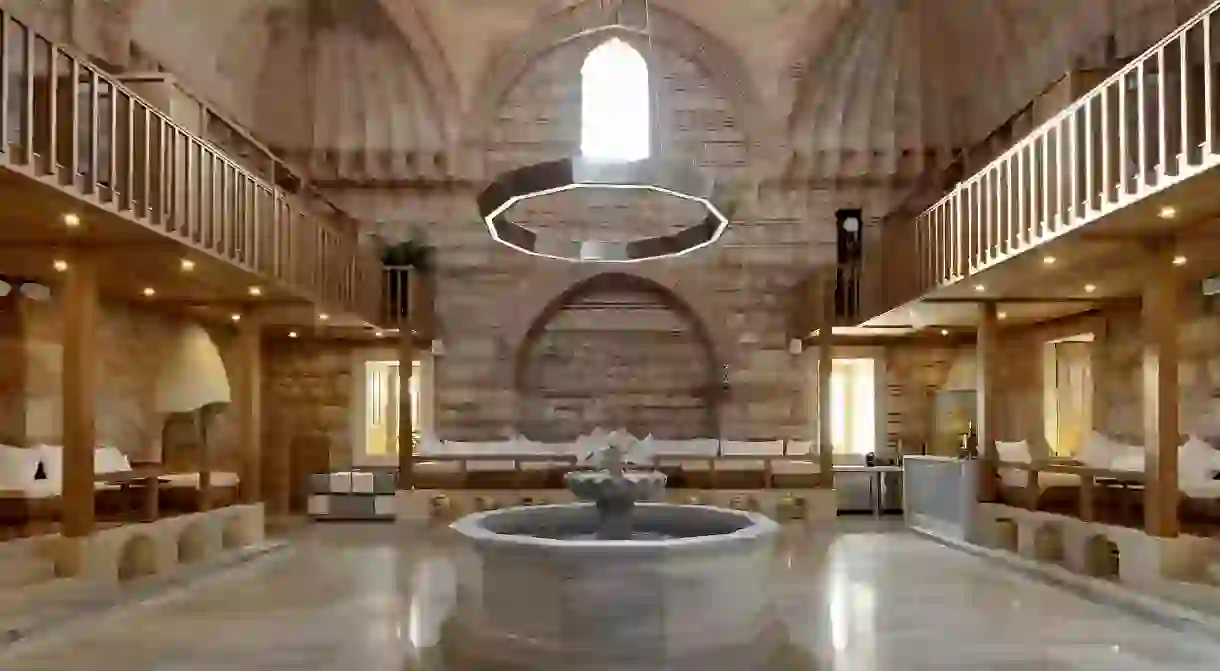The History and Rituals of Turkish Hammams in Istanbul

Istanbul’s painstakingly restored Ottoman hammams, many designed by the great Mimar Sinan, tell the stories of the historical figures who commissioned them, including sultans and powerful members of their harem and court. Visit these bathhouses for a scrub and a massage to join the long tradition of keyif (relaxing) in a serene environment.
The idea of a steamy hammam may bring to mind spoof scenes in the caldarium and frigidarium in the likes of Monty Python, Asterix and Carry On films, and the Turkish bath did indeed evolve out of the Roman bath. Istanbul was, after all, once part of the Roman Empire, before it became the glittering capital of the Byzantine and Ottoman Empires for 1,500 years, changing its name from Byzantium to Constantinople along the way. Turkey’s hammams, called Turkish baths by soapy European initiates, can tell the country’s long history through their lofty domes pierced with star-shaped windows. Check out some of the restored beauties in Istanbul’s UNESCO-protected Old City, where Byzantine emperors and Ottoman sultans used to enjoy a good scrubbing down before attending a chariot race or the mosque.

Great Ottoman hammams
Designed by the great 16th-century Ottoman architect Mimar Sinan, the Ayasofya Hürrem Sultan Hamamı faces the vast Byzantine bulk of the Hagia Sophia itself, and namechecks a woman who rose from being a slave girl to a powerful figure in the Ottoman Empire. Hürrem Sultan, AKA Roxelana, became the wife of the greatest sultan Süleyman the Magnificent, and ushered in a century of female influence on affairs of state known as the Sultanate of Women. Indeed, while many hammams have separate male and female sections (others have different hours for men and women; only tourist hammams allow mixed bathing), this bathhouse commissioned by Süleyman was the first to feature sections of equal size and stature for the two genders. Following a three-year, £10 million renovation, it offers soap-and-scrub packages starting at €55 for 30 minutes and massages from €40.

Ottoman hammam-building began with the empire itself in the early 14th century, and there are bathhouses by Mimar Sinan and others across Turkey, generally reflecting mosque architecture. The baths would often form part of a küllilye (mosque complex), due to Islam’s emphasis on personal cleanliness, and would generate revenue for the adjacent mosque, medrese (Islamic school) and charitable soup kitchen.
Next to Istanbul’s Grand Bazaar is another Sinan-designed stunner, the Çemberlıtaş Hamamı, commissioned by Nurbanu Sultan, wife of Süleyman and Roxelana’s son Selim II (AKA Selim the Sot) and mother of Murat III. While the debauched Selim is often credited with beginning the decline of the Ottoman Empire, Nurbanu Sultan effectively ran the government during her husband’s and son’s reigns and certainly commissioned a beautiful hammam, with a huge circular marble göbektaşı (heated platform) in both the men’s and women’s domed steam chambers.

Hammam scenes
Lounging and sweating on the göbektaşı is all part of the hammam experience, which typically begins in the camekan (entrance hall), followed by a visit to a halvet (changing cubicle) to put on your peştemal (bath wrap) and takunya (wooden clogs) or plastik çarıklar (plastic sandals). Next, follow the attendant through the soğukluk (cooling-down room) to the hararet (steam room) to join the semi-naked clientele, who sit on marble benches perspiring, languidly chatting and sloshing water onto themselves. Similar to Roman baths, the steam room is built on bricks and heated using ducts emerging from the kulhan (boiler room) beneath the göbektaşı platform. You can bring some shower gel and wash yourself, but for the full experience, sign up for a vigorous scrub and massage by an attendant wielding a coarse, grime-loosening kese mitt.

Between a session with the attendant, more sweating, a shower afterwards and a tulip-shaped glass of black Turkish çay tea in your halvet, perhaps even accompanied by some food or a nap, a trip to the hammam traditionally took hours. Many Turkish homes once didn’t have full bathrooms, with Turks hitting the hammam instead, and these bathhouses remain popular meeting places and a key part of the Turkish philosophy of keyif, or taking time to relax. In Portrait of a Turkish Family (2002), Irfan Orga’s memoir about growing up in Istanbul at the end of the Ottoman Empire, he recalls accompanying his grandmother to the hammam as a young child. “Nobody ever dreamed of taking a bath in anything under seven or eight hours. The young girls went to show off their pink-and-white bodies to the older women.” Orga describes the unofficial hierarchy of the steam room, where the mothers of eligible sons “lay aloof on their divans”, having their backs washed and being courted by eager bachelorettes and their mothers.

Taking a bath
Visiting the hammam today is less time-consuming, certainly less political and an unmissable experience for Istanbul first-timers and old hands alike. Another famous option is the Tophane district’s graceful Kılıç Ali Paşa Hamamı, which was designed by Sinan for Selim II’s chief admiral, Kılıç (‘the Sword’) Alı Paşa, and won a European Heritage Award in 2017 for its meticulous seven-year restoration. Mahmut I (AKA ‘the Hunchback’) built Cağaloğlu Hamamı in 1741 to fund the library he established in the nearby Hagia Sophia complex, after the Ottomans converted the Byzantine basilica to a mosque.
If you would like to try a less touristy hammam, remember that Turks call cockroaches hamam böceği (hammam insects) and cast an eye for cleanliness; but possible alternatives include the 15th-century Gedıkpaşa Hamamı and Edirnekapı’s Mihrimah Sultan Hamamı, part of the Sinan-designed külliye on the highest of seven hills within the old city walls. Wherever you soak, it’s quite something to reflect that centuries of hammam patrons have unwound in the same way, lounging on the marble and dreamily watching beams of light from the dome skylights illuminate the steam.













